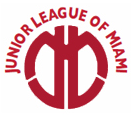Our History
Throughout the League’s history, the volunteering women of the Junior League have planted the seeds for many programs that are still part of this community today. Some have grown into major institutions, like the Children’s Home Society, begun in the early 1930s, and the Patricia and Phillip Frost Museum of Science (formerly Miami Science Museum), started by the League in 1949.
In more recent history, the Junior League has continued to dedicate its volunteer and financial resources to programs that tackle the toughest challenges facing today’s children and families. Teaming up with community partners, the League has helped develop CHARLEE, Guardian Ad Litem, Gladstone Center for Girls, INN Transition, the Family Visitation Center, the Children’s Cultural Connection and a myriad of other projects, all to fulfill a dream. . . for a better life for the children and families of our community, our greatest asset.
HISTORY OF THE ENCORE SHOP… AND FRANCES BENNETT
By Susan Revello (with updates in 2009 by Lorrie Martin)
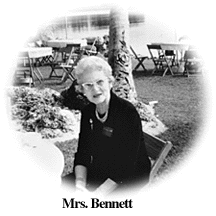 November 3, 1932, marked the beginning of what was to become the Junior League’s longest-running, most successful fund-raiser. The Junior League Thrift Shop opened at 304 North Miami Avenue, the first store to sell used clothing in Miami. The store “reigned alone in this particular marketplace of used and repaired merchandise . . .” until the idea caught on “like wildfire throughout the Greater Miami area” 20+ years later, The Miami Herald reported in 1964.
November 3, 1932, marked the beginning of what was to become the Junior League’s longest-running, most successful fund-raiser. The Junior League Thrift Shop opened at 304 North Miami Avenue, the first store to sell used clothing in Miami. The store “reigned alone in this particular marketplace of used and repaired merchandise . . .” until the idea caught on “like wildfire throughout the Greater Miami area” 20+ years later, The Miami Herald reported in 1964.
An Early Blessing
A month after its opening, a very special woman by the name of Frances Bennett began her long relationship with the shop as manager. Mrs. Bennett remained with the shop for 46 years, until she retired in 1978 at age 81.
The words “legend” “colorful” and “gutsy” came up when I asked sustainers about this remarkable woman who ran the shop in a very strict manner. It seems all the sustainers remember her.
There were stories about her running for blocks chasing down people who stole items from her beloved store. For her 35th year of service, the Junior League presented Mrs. Bennett with a trip to Europe. Mrs. Bennett later said this opportunity was “the happiest moment of her life.” She passed away in the early 1980s.
A year and a half after opening, the shop moved to 405 North Miami Ave., where it remained for the next 30 years. A partition in the rear of the store marked the areas where the articles on consignment were sold. A shoe department had “shoe chairs” scattered for convenience. Toward the back was a balcony where League members marked donations.
The store was near many low rent boarding houses, and the tenants would use the shop as a gathering place. A Coca-Cola machine in the shoe department served as a gathering spot for men and women who came in, sat down on shoe chairs, and discussed the problems of the day. The clientele was so large that throngs of people waited to come in each morning.
In an interview with Mrs. Bennett in 1977, she recalled with nostalgia the delight that the shop brought to customers during the Christmas season. At 3 p.m. on a designated day, the League members would bring all of their finery: silver trays, punch bowls, linen table cloths, and serve punch and cookies to the customers. For some people, this was their only holiday experience and they were very grateful.
The Coffee Tradition
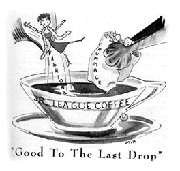 The annual Thrift Shop Rummage Coffee is a tradition dating back to 1939 when the first one was held at the Pine Tree Drive home of Mrs. Strongman Miller. Every November, these public events at “well-known” residences became increasingly popular. In 1960, Janet MacNeill reported that “last year’s extravaganza at the estate of Arthur Vinning Davis,” brought in 900 bags, enabling the store to make $1,200 in sales the next day. At times the shop had police protection to keep people from charging the doors and pilfering the goods. (A modified form of this event continues today as the Sustainer Coffee-a tradition now for starting off the “League year” which was used as a way for gathering goods from sustainers, and never with an incident of pilfering!)
The annual Thrift Shop Rummage Coffee is a tradition dating back to 1939 when the first one was held at the Pine Tree Drive home of Mrs. Strongman Miller. Every November, these public events at “well-known” residences became increasingly popular. In 1960, Janet MacNeill reported that “last year’s extravaganza at the estate of Arthur Vinning Davis,” brought in 900 bags, enabling the store to make $1,200 in sales the next day. At times the shop had police protection to keep people from charging the doors and pilfering the goods. (A modified form of this event continues today as the Sustainer Coffee-a tradition now for starting off the “League year” which was used as a way for gathering goods from sustainers, and never with an incident of pilfering!)
The Encore Shop Name is Born
In 1964, the shop changed its location again, and its name as well. It was moved to 118 N.W. 1st Avenue, across from the courthouse and the bus stop, now the location of the Metro-Dade Cultural Center. The League ran a contest to think of a new name. Mrs. Sheldon Morehead’s suggestion won–Junior League Encore Shop–a name that remained with the shop from that day forward to its closing.
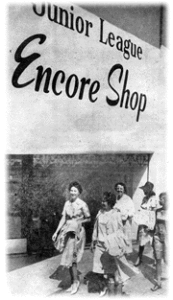 Along with the new shop name came enhancements. The shoe department and men’s clothing were eliminated and more boutique items were accepted. The caliber of the clothes accepted was upgraded, and no more clothes were accepted on consignment.
Along with the new shop name came enhancements. The shoe department and men’s clothing were eliminated and more boutique items were accepted. The caliber of the clothes accepted was upgraded, and no more clothes were accepted on consignment.
The opening of the new Encore Shop in 1964 had been highly publicized, making it necessary to engage police protection for the event. The new shop was very small and a mob of customers wanted in. Policemen controlled the crowd by allowing them to enter and leave the store two at a time.
The clientele consisted primarily of secretaries from offices in the downtown area, however, many of the shop’s old customers followed them to this new location, where the shop remained for the next 11 years.
Move to the Gables
In 1975 the Encore Shop moved to the Parker Arts Building on Aragon in Coral Gables. The merchandise was once again upgraded, along with the appearance of the shop. In 1981 it moved to Coral Gable’s converted old firehouse, 2325 Salzedo Street, with the League’s headquarters sharing adjacent space. In 1997, the Shop moved around the corner to bigger space to allow for more merchandise, 269 Giralda Avenue, where it remained until it was closed in 2004. The era of “business casual”, competition from bargain stores for similar merchandise, and increasing cost to do business were some of the factors that led to the decision to close the shop after 76 years of serving the community– not an easy one to make for anyone involved.
In the tradition of Frances Bennett, Mildred Helms graciously served as store manager for more than eight years. Mildred combined a pragmatic sense of style, a sharp business sense and keen customer relations skills. The store always had a fresh look, fabulous clothing and low prices.
When asked why she believes the Encore Shop was so successful, Mildred replied, “It is definitely a service to the community. Customers like it not only because of its appearance and its current, stylish clothes, but because it is such a pleasant shopping experience. In fact, some of the regular customers call it their “therapy.”
Therapy indeed! The fact is that the Encore Shop was the biggest source of income for the Junior League of Miami, since its inception in 1932. To all those women who contributed to its success – hats off!
HISTORY OF THE LEAGUE’S INVOLVEMENT WITH CHILDREN’S ISSUES
By Barbara Lagoa
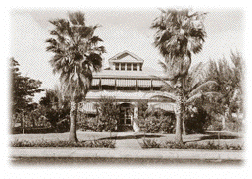 The Junior League of Miami (JLM) has been involved in children’s issues and programs since its inception, beginning with a child guidance clinic under the direction of Dr. Tom Williams in 1926. The following year the League began its holiday toy drive, a tradition maintained today. In 1929, a children’s theater project was implemented. Junior Leaguers donned costumes, created the sets and staged performances of Snow White, The Wizard of Oz and Jack and the Beanstalk. This highly successful, long-running program was turned over to the community in 1947-48.
The Junior League of Miami (JLM) has been involved in children’s issues and programs since its inception, beginning with a child guidance clinic under the direction of Dr. Tom Williams in 1926. The following year the League began its holiday toy drive, a tradition maintained today. In 1929, a children’s theater project was implemented. Junior Leaguers donned costumes, created the sets and staged performances of Snow White, The Wizard of Oz and Jack and the Beanstalk. This highly successful, long-running program was turned over to the community in 1947-48.
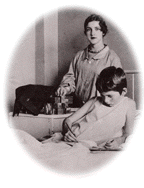 The first major social project undertaken by the JLM began in the wake of the 1926 hurricane and the beginning of the Great Depression. In 1931, the Children’s Home Society of Florida was forced to close its southeastern branch. The League was approached by the Children’s Home Society founder to assume full responsibility for the home. Under the courageous leadership of League President Kay Pancoast, the decision was made to undertake this ambitious and challenging project.
The first major social project undertaken by the JLM began in the wake of the 1926 hurricane and the beginning of the Great Depression. In 1931, the Children’s Home Society of Florida was forced to close its southeastern branch. The League was approached by the Children’s Home Society founder to assume full responsibility for the home. Under the courageous leadership of League President Kay Pancoast, the decision was made to undertake this ambitious and challenging project.
On January 1, 1931, JLM took ownership of the Children’s Home Society’s receiving home and changed the name to the Junior League Children’s Home. Anne Farley Bellenger was the first chairperson of this project which cared for 90 children in its first year.
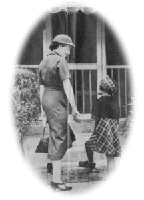 In 1936, the Junior League returned the home to the Children’s Home Society and looked to broaden its scope of work in this area. The League then founded the Children’s Service Bureau of Dade County, Inc. in 1936-37, which assisted in foster placement for children.
In 1936, the Junior League returned the home to the Children’s Home Society and looked to broaden its scope of work in this area. The League then founded the Children’s Service Bureau of Dade County, Inc. in 1936-37, which assisted in foster placement for children.
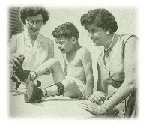 Martha Lummus, president of the Junior League in 1935-36, remembers when Dr. Carstens, then head of the Welfare League of America, came to Miami to conduct a survey to identify the most needed project for the League to support. He recommended the formation of the Children’s Service Bureau.
Martha Lummus, president of the Junior League in 1935-36, remembers when Dr. Carstens, then head of the Welfare League of America, came to Miami to conduct a survey to identify the most needed project for the League to support. He recommended the formation of the Children’s Service Bureau.
“The board agreed to that as a project, and the wheels began turning to create it,” Martha tells us. Turning indeed! The League has been involved with the Children’s Home Society and other children’s agencies ever since.
In fact, during the early Operation Pedro Pan, this League project, in connection with the Catholic Children’s Service assisted in finding foster homes for the many Cuban children whose parents, fearing the Communist regime in Cuba, sent their children to Miami.
A variety of projects have continued ever since, like Teenage Shelter Care (TASC) in 1991-93, in which Leaguers mentored troubled teens.
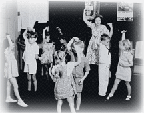 Children and the Arts
Children and the Arts
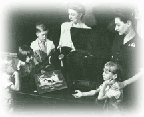 During the late 1930s the League broadened the scope of the Children’s Theater Project by conducting a survey of the arts available for children, and adding a weekly Children’s Dramatic Reading on WIOD radio. In addition, the Children’s Service Bureau became a Community Chest Agency (now The United Way) and a Family Service Bureau was formed. During the war years of the 1940s, the League’s efforts, like those of the rest of the community, were turned to War Relief. Past President Evelyn Rutledge remembers how the League couldn’t do their League projects and help with the war effort. For the first time, the League paid for outside help at the Thrift Shop.
During the late 1930s the League broadened the scope of the Children’s Theater Project by conducting a survey of the arts available for children, and adding a weekly Children’s Dramatic Reading on WIOD radio. In addition, the Children’s Service Bureau became a Community Chest Agency (now The United Way) and a Family Service Bureau was formed. During the war years of the 1940s, the League’s efforts, like those of the rest of the community, were turned to War Relief. Past President Evelyn Rutledge remembers how the League couldn’t do their League projects and help with the war effort. For the first time, the League paid for outside help at the Thrift Shop.
However, as soon as the war ended, children’s programs re-emerged as the League’s focus area with the establishment of a Children’s Music and Story Program and a Radio Program for children. These program soon encompassed all of the elementary schools in the county. Historian Arva Moore Parks remembers winning a prize for reading the most books which she was in school. In 1947 all these children’s programs were officially recognized when the JLM was appointed to League to the Florida Children’s Commission. These early programs in the arts “paved the way for Art Path” and other programs of the JLM in more recent history,
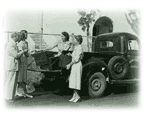 Arva explained.
Arva explained.
In 1949-50, the JLM established the Junior Museum, which was to become the Museum of Science and Natural History in 1959, and is known today as the Miami Museum of Science and Space Transit Planetarium.
Betty Purvis, president that year, remembered the League holding their board meetings in the upstairs portion of the house in which the first museum was located. Marie Louise “Babe” Dowlen remembered during her presidency a few years later the JLM started the Museum of Science Guild, which still provides major volunteer support to the Museum.
Countless volunteers worked on the museum committee for many years, nurturing it in its foundling years. It now hosts more than 300,000 visitors a year. The League’s work on this effort brought it first prize in The Miami Herald‘s “Club of the Year Contest” in 1956-57.
During that same year, the League branched into television with the production of “Operation Junior” a children’s show on Channel 2.
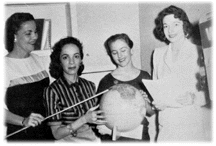 The 1960s brought continued involvement in the Museum of Science and Natural History, as well as other children’s programs and issues. The League purchased “Williamsburg: Story of A Patriot” for Dade County Schools, made a $5,000 donation to help establish the Children’s Society Service Bureau’s Esquire House and started a “Youth Volunteer Program” as part of an ongoing volunteer program.
The 1960s brought continued involvement in the Museum of Science and Natural History, as well as other children’s programs and issues. The League purchased “Williamsburg: Story of A Patriot” for Dade County Schools, made a $5,000 donation to help establish the Children’s Society Service Bureau’s Esquire House and started a “Youth Volunteer Program” as part of an ongoing volunteer program.
In the 1980s the League strived to broaden the horizons of children with Art Path programs. These programs provided valuable museum experiences for Dade County elementary school students and encouraged them to view works of art for self-enrichment.
Betty Fleming, Junior League sustainer, spent several of her active placement years working with this program and recalled the many tours the League conducted for children at the Center for the Fine Arts, now called the Miami Art Museum.
“We took thousands of children through the museum,” Betty said, “It was a tremendous program and we were sad to see it end.”
In addition, the League funded and provided volunteers for the Miami City Ballet’s “Ballet for Children” program, and assisted the Inner-City Children’s Touring Dance Company, under the direction of Florene Nichols, for three years, 1989-92. Provisionals and other Leaguers helped staff Kaleidescope, a traveling arts and craft facility for children when it came to Miami in 1988-89.
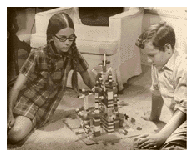 Drug Awareness for Children
Drug Awareness for Children
As drugs became a problem with youth in our community and throughout the nation, the League produced a film “Drugs Are Like That.” This award-winning film circulated through school systems both locally and nationally well into the 1970s. It educated tens, perhaps hundreds of thousands of children on the dangers of drug use.
In the 1980s, drug education continued with programs such as GATE and Informed Families, which has grown into a strong drug education organization.
Advocacy for Children
Child advocacy was a strong focus of the League during the 1970s. In 1973 the League became involved in a court advocate program called “Court Watch” which has lead us through the years to new programs for children (including Kristi House, a current League program).
Berta Blecke, one of the League’s most outstanding advocates for children, was a part of this program and became friends with the Honorable William Gladstone, the Chief Judge for the Juvenile Court System. He helped the League implement a project called Children in Placement. Through this project it became clear that children needed to have a guardian appointed to them to ensure that their cases would not get lost in the court system.
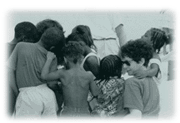 With this in mind, in1980 the Guardian Ad Litem Project was born and continues today. During this same time the League was a co-sponsor for the Parent Resource Center which is still providing parenting skills education in our community as the Family Resource Center. In addition to Guardian Ad Litem, the League co-sponsored a seminar on violence in the schools, instituted an “Ambassadors for Public Education” program and continued to become more and more involved in many areas of child advocacy. During the mid-1980s, the League was instrumental in getting school-based health clinics started. (Today we are implementing the pilot program for Hepatitis B immunization in a middle school.)
With this in mind, in1980 the Guardian Ad Litem Project was born and continues today. During this same time the League was a co-sponsor for the Parent Resource Center which is still providing parenting skills education in our community as the Family Resource Center. In addition to Guardian Ad Litem, the League co-sponsored a seminar on violence in the schools, instituted an “Ambassadors for Public Education” program and continued to become more and more involved in many areas of child advocacy. During the mid-1980s, the League was instrumental in getting school-based health clinics started. (Today we are implementing the pilot program for Hepatitis B immunization in a middle school.)
The late 1980s and on into the 1990s found League members designing a volunteer program for the McLamore Children’s Center, a temporary shelter for abused, abandoned and neglected children. In addition, child care issues were addressed by establishing a day care center in the Modello Housing Project, in South Dade. We also became involved with issues for disabled youth by supporting the Junior Orange Bowl’s Sports Ability Games.
In 1985 the Kathryn Menke Miller Award was established in honor of one of our members killed tragically, a victim of violent crime. This award is presented to a young woman graduating from each public high school in Dade County who demonstrates dedication to voluntarism just as Mrs. Miller did.
Other children’s projects of the 1990s have included Dade Public Education Impact II, ResourceMobile and Kids Voting. All share the same characteristics: innovative, educational and child-focused.
The JLM’s history with children’s programs and issues is varied and rich. It has been an integral part of who and what the League stands for since its beginning to the present. Throughout our history the League has offered solutions to the problems affecting our most precious resource: our children.
BUILDING A MUSEUM
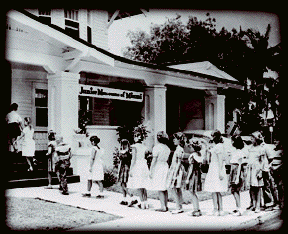 In 1950 in a small house on Biscayne Boulevard and 26th Street, today’s Miami Museum of Science & Space Transit Planetarium was born. Known as the Junior Museum of Miami, women of the Junior League of Miami started it with a little seed money and lots of volunteer hours.
In 1950 in a small house on Biscayne Boulevard and 26th Street, today’s Miami Museum of Science & Space Transit Planetarium was born. Known as the Junior Museum of Miami, women of the Junior League of Miami started it with a little seed money and lots of volunteer hours.
Thousands of kids toured the new museum’s exhibits, which included a goat on the lawn and a bee hive in the chimney, according to Sustainer Lamar Adams. Betty Purvis, past president of 1949-50 recalled that the museum was so popular, it quickly outgrew its first home, and then its second.
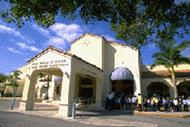 In 1960, thanks to the vision of Miami-Dade County planners, the museum moved to its current location on the Vizcaya complex at 3280 South Miami Avenue… and is still growing. The Junior League of Miami turned the museum over to its own governing board in 1959, but continued to support the museum with volunteers and funding assistance through the 1960s. The League founded the Museum Guild in 1953, a volunteer museum support group, still going strong today running the entire Museum Store, among other activities.
In 1960, thanks to the vision of Miami-Dade County planners, the museum moved to its current location on the Vizcaya complex at 3280 South Miami Avenue… and is still growing. The Junior League of Miami turned the museum over to its own governing board in 1959, but continued to support the museum with volunteers and funding assistance through the 1960s. The League founded the Museum Guild in 1953, a volunteer museum support group, still going strong today running the entire Museum Store, among other activities.
Today, the Miami Museum of Science is a major center for scientific education, research and exhibition, and a vital community resource. It’s a community gem shared by both the community and the Junior League of Miami.
HISTORY OF TROPICAL TOPICS MAGAZINE
By Mary Crandall (with updates in 2009 by Lorrie Martin)
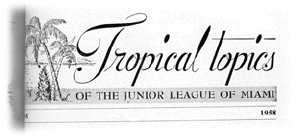
One can imagine a bunch of “girls” sitting around a warm parlor room fanning themselves as they wrote their articles for Tropical Topics. The reason I call them “girls” is because that is what they called themselves back in 1931. They were probably using those beautiful quill pens to write their poems and articles, then taking their articles to The Printcrafters Inc., where their work was then printed onto green paper in a flier format, half the size of our current Tropical Topics.
While looking through the articles they wrote in 1931, I learned about some of the problems they were experiencing. They wrote about how many of the banking institutions were failing, so they kept losing the money they had saved for League projects.
There were articles on the following: dressing “swank;” home notes, where children (from their Children’s Home Project) were being placed; plays they were putting on in the community to raise money; book reviews; articles on trips some of the members had taken to various places, such as “Notes On The Orient,” and information about the new provisional class.
You can recognize the more mischievous articles by their titles alone: “What Husbands Think of the Junior League,” “On Being a Model,” and “A League Son Speaks.” I couldn’t help but laugh at the humorous articles they had written. Here are some excepts from two of those articles:
“What Husbands Think Of The Junior League”
“I do not believe that any member of the League really cares a hoot what her husband (if she has one), or any member’s husband, thinks about the League. I cannot think of any good reason why husbands’ opinions on the subject should count, one way or the other. However, your very persuasive editor suggested this title. With the foregoing defense, I shall try to define the attitude of husbands towards the League. . .Another objection ofttimes heard is that the husband wearies of hearing the affairs of the League discussed. In view of the fact that most of us are unable to talk for five minutes except about business, golf, or scandal, I cannot believe that this objection can be urged with any degree of seriousness. It is my sincere conviction that the real attitude of the husband towards the Junior League is that he would be very much distressed had his wife not been invited to join; that he cannot help but profoundly admire the work the League is doing; that he would really like to say so, and would, but for the fact somewhere he has heard that women were frivolous, incompetent and incapable of perseverance. . .” (See also Husband’s Lament below)
“A League Son Speaks”
Paul R. Scott wrote:
“When Misses Barco asked me to rite a peece saying what I thot of the Jr. Leeg I knew she wouldn’t print all I realy thot so I will just rite part. But I will try to be fare & forget that some one put my pictcher in the paper with a lot of other kids and called us all Perspective Jr. Leegers which made me get razzed something terrible. I think it is allright for my mother to belong to the Jr. Leeg because I am pretty old now and can take care of myself. Its just babies afraid of strangers that cry when they see their mothers come in. Working at the children’s home or the hospital gives her something to do when I am busy or at school. I like to have her go to the hospital the best. She smells funny when she gets home but she sees people who were smashed up & once she saw a banditt that was shot and quite bludy. That is more exciting than kids with hooping cough which I have allready had. Rummedge sales are pretty dum. Once she bot me a pair of slippers for a nickle that were too small & another time she bot me a pair of book ends for a dime that fall off if I take out a book. Yesterday when she was going over to the children’s home to manage the playground or something, Daddy peaked over his newspaper & said something like this:
I quite appruve of charaty
Filantropy is fine
But while you tend those little ones
Pray who looks after mine?
I laffed, but mother just looked pashent and put on her hat. In conclusion I will say I am glad I am not a girl and will never have to belong to the JR.Legg.”
Advice Column
The article on being a model was also just as humorous. I was thinking to myself what a fun bunch of “girls”to have worked with. They were always thinking of funny things to write about one another. How about this list of “Don’ts for Provisionals” from 1932:
DON’T let your mind wander or your foot slip on the dizzy peaks of Parliamentary Law.
DON’T let your expression show how your legs feel after the first meeting.
DON’T forget that you are to be seen and not heard.
DON’T forget that you are sent to the home for the moral and social, but not the political upbringing of the children.
DON’T be fainthearted at the first blow-there are more to follow.
DON’T get discouraged – life is like that.
As the years passed, the articles began to reflect more of the activities the members were involved in. A regular editorial began to appear. One that made an impression on me was written by Anne Copeland where she made the following statements:
“As we look back over the year just passed, we cannot help but feel proud of the accomplishments of the League, especially in view of the nationwide economic conditions. . . .Our fondest hope is that in editing the Tropics for the ensuing year we may broadcast monthly bigger and better Junior League accomplishments and we feel certain that if the same ambition is cherished by all our members that this ‘fondest hope’ will not only be attained but surpassed.”
The Economic Equation
Since I am on the staff of Tropical Topics, I thought I would share with you the fact that the editor is always talking to us about “getting advertisements.” I wish I had a nickel for every time she has said that to me. I thought perhaps she was just picking on little ol’ me when I found an article from the early years where the editor was pestering everyone in the League (even the provisionals) to sell an ad. They managed somehow to put a funny quip about the difficulties they faced when they were trying to sell an ad. Now I know, it’s not just me. Some things change over the years but many stay the same!
Getting Better All the Time
In January 1963, the cover of Tropical Topics had a big balloon drawn on it with the center filled with silver and red sprinkles glued to the outside cover. On the inside was a red stone attached to another picture.
While the JLM continued with our mission of helping the community, we professionalized the look of the League magazine to glossy pages with beautiful pictures and splashes of color. The articles took a serious look at our programs and their role in addressing community challenges.
While we still had a lot of fun (like the “girls” used to) when we went over to the editor’s home to work on our articles, we evolved as an organization. We no longer used typewriters, most of us were quite proficient with computers and disks! I’m not sure how they functioned before fax machines ever came along. My editor would be on the phone with me asking “Where is it (this article)? Did you mail it today?”, but I just smiled and hit the fax button and appreciate how far we’ve come.
Now that the League has moved to the format of the Junior League Journal, (which has in itself evolved from more of a newsletter format to a mix between member news and community interest), Tropical Topics will always hold a special place in our heart and our history. The reporting encompassed a great deal of our community, not just League happenings. Following are links to some archived copies of Tropical Topics.
Husband’s Lament
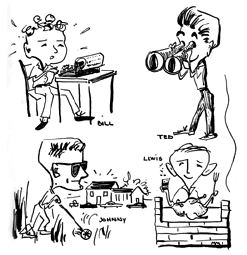 There is a dark conspiracy,
There is a dark conspiracy,
There is a deep intrigue,
That tries to rob me of my wife
It’s called the Junior League.
There once were smiles and gaiety
About my sweet abode,
But now, my wife is never home,
She’s somewhere on the road.
Dust has gathered on the floor
The dishes in the sink
Unless I see my wife once more
I soon may take to drink.
I cannot use my telephone
I’m in a sorry plight,
Because with some provisional
She’s talking day and night.
And so it seems that I am doomed
To monologues profaning
Until she joins that holy group
Of membership sustaining.
By Graham Miller
-Tropical Topics, November 1951
THE REBECCA HERNDON BUSH LEGACY
By Zanze Fowler
Bush, Batchelor and Blecke. Dating back to 1926, these three Bs have had a tremendous impact on the Junior League of Miami which is still felt strongly today. Rebecca Herndon Bush, her daughter Lucy Bush Batchelor and granddaughter Berta Batchelor Blecke have been influential in shaping this League and its programs.
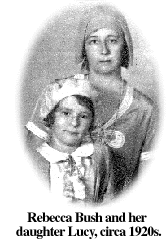 Mrs. Bush served as the first president of the Junior League in 1926-27 when the Miami chapter was admitted into the national Association of Junior Leagues. In addition, Alberta Williams Bush, Rebecca Bush’s mother-in-law was also an active Junior Leaguer living in Birmingham, Alabama, in 1926. Consequently, it was the Birmingham League which sponsored the newly formed JLM, allowing the organization to become officially sanctioned.
Mrs. Bush served as the first president of the Junior League in 1926-27 when the Miami chapter was admitted into the national Association of Junior Leagues. In addition, Alberta Williams Bush, Rebecca Bush’s mother-in-law was also an active Junior Leaguer living in Birmingham, Alabama, in 1926. Consequently, it was the Birmingham League which sponsored the newly formed JLM, allowing the organization to become officially sanctioned.
I recently spoke with Mrs. Batchelor and her daughter, Mrs. Blecke, about their experiences during their active years in the League.
Mrs. Batchelor also shared some of her fondest childhood memories when her mother, Rebecca Herndon Bush, served as president. She remembered playing “dress-up” in the gypsy costumes that were worn at the first fund-raising ball and recalled helping her mother create crepe paper decorations that adorned the Biltmore Hotel.
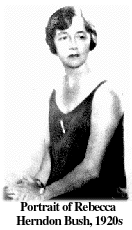 For those of us who know Lucy Batchelor and Berta Blecke personally, their dedication and commitment is very apparent. Mrs. Batchelor shared a story that truly embodied her kindness. The setting was 1960, when plane loads of Cuban children were arriving in Miami every week. The Junior League, the Children’s Service Bureau and area churches were all trying to find homes for these children.
For those of us who know Lucy Batchelor and Berta Blecke personally, their dedication and commitment is very apparent. Mrs. Batchelor shared a story that truly embodied her kindness. The setting was 1960, when plane loads of Cuban children were arriving in Miami every week. The Junior League, the Children’s Service Bureau and area churches were all trying to find homes for these children.
Mrs. Batchelor did not have a problem placing the younger children, but no one wanted to take the teenage boys. Many people were afraid to take teenagers into their homes. When she realized that no homes were available for these boys, she took them in herself. Eventually permanent homes were found in other states, but these boys always kept in touch with her, and she fondly shows off the many letters she has received over the years.
Growing up in this kind of home, with role models such as her mother and grandmother, it is no surprise that Berta Blecke was the guiding force behind many of the Junior League’s projects. She is very committed to improving the quality of life for children who have been neglected by the system, as well as their own families. Serving in the Guardian Ad Litem Program is where she met Judge William Gladstone.
And as she put it, “He had a LOT of ideas.”
Many of those very ideas wound up being voted upon by the League membership in the form of funding and staffing recommendations for various projects. Eventually, Berta was influential in bringing the CHARLEE (Children Have All Rights – Legal, Educational and Emotional) Program to Miami. This successful program places emotionally disturbed children who have been rejected by all other foster homes into a CHARLEE home under the supervision of stable house parents trained to deal with the children’s problems. A stable environment coupled with counseling, fosters these children’s growth and maturity and prepares them to live independently once they turn 18.
Berta and Judge Gladstone also teamed up to address a terrible social disease with the new Gladstone Center for Girls, a current League project. This is a facility for sexually abused girls to receive medical treatment, counseling, and schooling, with the ultimate goal of placement back with a family member. Now that the Gladstone Center is fully operational, Berta has by no means sat back and taken it easy. She informed me that there is a Boy’s Center becoming a reality in the near future.
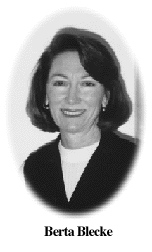 The Junior League has influenced each one of our lives. But, did you know that thanks to Lucy Batchelor, the Junior League has influenced some of this state’s most hardened criminals? No, there isn’t a Junior League in prison, but Mrs. Batchelor took Robert’s Rules of Order and formed various service-type clubs within the state’s prison system. She said that she treated everyone just like the Junior League treats its members. Thanking them for coming to the meetings, telling them that they can make a difference, how to vote on matters that were before the membership, etc. She said, “Many of the men I counseled told me that if they had learned the human relation skills she taught them when they were young, they would not have ended up in prison.”
The Junior League has influenced each one of our lives. But, did you know that thanks to Lucy Batchelor, the Junior League has influenced some of this state’s most hardened criminals? No, there isn’t a Junior League in prison, but Mrs. Batchelor took Robert’s Rules of Order and formed various service-type clubs within the state’s prison system. She said that she treated everyone just like the Junior League treats its members. Thanking them for coming to the meetings, telling them that they can make a difference, how to vote on matters that were before the membership, etc. She said, “Many of the men I counseled told me that if they had learned the human relation skills she taught them when they were young, they would not have ended up in prison.”
In honor of the family’s matriarch, in 1987 the JLM established the Rebecca Herndon Bush Service Award. This award is given to the active member who has contributed exceptional service to the community for each fiscal year. Appropriately, Berta Blecke was the first recipient of the award. Others honorees include Claudia Crimmen Kitchens, Sara Barli Herald, the late Ronni Weksler Bermont, Jayne Harris Abess, Deborah Thornton Hasty, Lynn Summers, Julia Rea Bianchi, Linda Cooks-Taylor, Susan Moll, Karen Nordt and in 1998, Alison Gunn.
Lucy Batchelor and her daughter Berta Blecke are an inspiration to me and I imagine to just about everyone they meet. Mrs. Batchelor’s stories are fascinating and memorable, like the way she expresses her feelings for the Junior League: “The graciousness with which the Junior League welcomes its members and the opportunities for learning are unique gifts.”
From our vantage point, the “gift” was all ours, having these remarkable women as part of our organization.
FUNDRAISING THROUGH THE DECADES
By Mary Young, President 1998-99, Vice President of Finance, 1994-95
With the belief that “success is a journey-not a destination,” the Junior League of Miami (JLM) has had an incredible journey of fund and “friend raising” during its first 70 years-with the help of its membership and our community. Always focused on those in need, the members of the JLM have contributed millions of dollars and supplemented this financial support with immeasurable amounts of precious time, love, and energy to its causes.
Our fund-raising activities have reflected the changing face of our members and community, and have always been focused on how we might make the greatest contribution and impact on our projects. As a salute to all those who have been in the fund-raising trenches for the League, this briefly recaps our incredible journey through the decades.
The 1920s
In its infancy, the League established a tradition of diverse fund-raising efforts. The very first fund-raiser was held in 1925, just two months after the original 24 women got together to think about forming a League in Miami. The event was a dance on August 5, 1925, at Coral Gables Country Club, from 10 p.m. to 1 a.m. to “raise funds to establish a free dental clinic for the school children of Miami,” according to a Miami Daily News report.
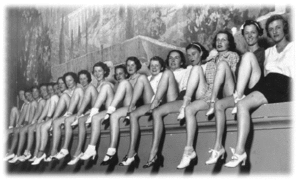 In 1927 the JLM entered the retail world with a Gift Shop at the Roundtable Tea Room on Flagler Street. Janet McNeill reported on this early effort in a 1960 Tropical Topics: “The luncheon guests would pass through the anteroom where the Gift Shop displayed hand-made articles and donations of lovely things from the girls.”
In 1927 the JLM entered the retail world with a Gift Shop at the Roundtable Tea Room on Flagler Street. Janet McNeill reported on this early effort in a 1960 Tropical Topics: “The luncheon guests would pass through the anteroom where the Gift Shop displayed hand-made articles and donations of lovely things from the girls.”
The first JLM Benefit Ball, a benefit bridge party, a musical concert, the Orange Ball, the first JLM edition of the Miami Daily News, and our first children’s play, Snow White, laid the foundation of raising money to enable such early projects as the Children’s Home Society and the Occupational Therapy Ward at Jackson Memorial Hospital. The patients in the Ward at Jackson helped to supply inventory for the Gift Shop in the form of the arts and crafts they created, “to help take their minds off depression,” according to a 1928 newspaper account.
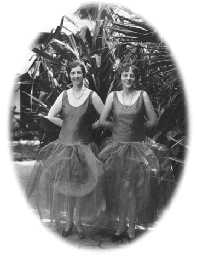 The 1930s
The 1930s
During the 1930s, the conventional annual balls continued, however, the Gift Shop evolved into the League’s Thrift Shop carrying all kinds of “rummage” (known today as our “Encore Shop”). In addition to what had now become traditions of retailing and charity ball fund-raisers, the 1930s saw the addition of the “Hialeah Race Day” (raising more than $22,000 in 1930!), the abandonment of the Miami Daily News due to two years of SURPLUS funds and the introduction of such new fund-raisers as a Fashion Show and “Junior League Day” at Burdines, a musical recital, a “Town Hall” series . . . and the introduction of the Rummage Tea, as well as the popular League Follies. The Thrift Shop moved to 405 North Miami Avenue.
The 1940s
With our emphasis on supporting the nation’s war efforts during World War II, fund-raising efforts were sometimes modified and the Thrift Shop, Annual Ball and Rummage Tea were ALL suspended during 1941 and 1942. The Thrift Shop remained our anchor fund-raiser through the decade, and was actually staffed in 1943 by paid workers in order to release highly-trained Junior League volunteers to better support the war tasks in Miami. To help subsidize these workers, dues were increased to $15 per member in 1946.
The 1950s
The Thrift Shop continued to be the primary source of income with such new additions to our efforts as co-sponsorship of the Annual Horse Show, a Charity Fashion Ball with Burdines and Town & Country Magazine, and our first monies from the Community Chest (the precursor of the United Way) to support our project, the Junior Museum (now the Miami Museum of Science), established by the Junior League of Miami with just $5,000. While celebrating our 25th year of service, with a Silver Anniversary Ball, we also raised members’ dues to $20.
The 1960s
The Thrift Shop moved and became the “Encore Shop” in 1964 under the leadership of President Lamar Adams, who well remembers the tremendous year-long job it was to move everything. The Shop generated net proceeds during the decade of more than $67,000. Dues were raised to $30 per member and in 1969, Channel 2 awarded the Junior League of Miami a matching grant of $5,000 for our film Drugs Are Like That. We celebrated our 35th year with an Anniversary Ball and continued today’s enduring tradition of an Encore Shop Coffee (or Tea) .
The 1970s
The Encore Shop continued through the decade, contributing more than $132,000 from 1975 through the end of the decade. The first “Designer Show House” took place in 1972 with proceeds from this fund-raiser exceeding $81,000 through the 1970s. To continue to promote member participation in our retail endeavors, the Encore Shop quota was raised to $48 per member in 1974.
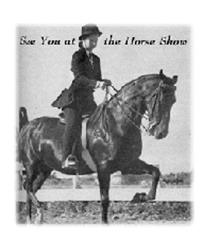 The 1980s
The 1980s
With more than $428,000 raised during the 1980s from the Encore Shop alone, other diverse fund-raisers such as a Holiday Bazaar, the continuation of the Show house, a “Hair Cut-a-Thon,” the Virginia Slims Florida Tennis Tournament, Burdines- “A Taste of Italy,” and the YMCA Network Holiday Happening were implemented.
In 1985, under the leadership of President Becky Matkov, “Miami Magic,” a progressive gala through our city largely tapping corporate underwriters, was introduced. Through an evening of fund and friend-raising, almost $800,000 for League projects was raised by ticket sales and corporate underwriting of this gala during the years 1985 to 1989.
The 1990s
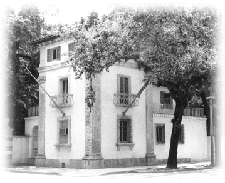 The Encore Shop has continued to thrive and as of 1995 had contributed $423,000 to this decade’s revenues. Miami Magic in 1990 and 1991 contributed more than $125,000. The final Miami Magic was held in April 1992, under the leadership of Mary Mills, with a net of $68,700.
The Encore Shop has continued to thrive and as of 1995 had contributed $423,000 to this decade’s revenues. Miami Magic in 1990 and 1991 contributed more than $125,000. The final Miami Magic was held in April 1992, under the leadership of Mary Mills, with a net of $68,700.
With Hurricane Andrew and changes in the corporate climate in Miami, Miami Magic was replaced by an Auction Gala in 1993. During the next three years, the dinner/auction contributed almost $200,000 to League projects and we began to focus our fund-raising efforts to other sources than merely “our own.”
The years 1993 through the present saw more than $3 million committed to our South Dade Transitional Living facility from a variety of sources such as the Knight Foundation, “We Will Rebuild” (spawned from the devastation of Hurricane Andrew in 1992), and the Dade County Homeless Trust. We also raised $15,000 in 1993 from the Liz Claiborne Foundation, $10,000 from the Women’s Relief Association in 1995 and another $58,000 in 1996 from the Coral Gables Rotary Club to benefit Inn Transition.
With more than $100,000 committed to the “Ronni Bermont Endowment Fund,” additional monies and in-kind donations were also obtained to support the “227-A Kid’s Place.”
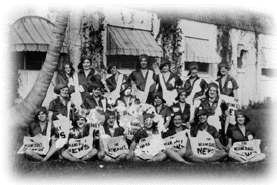 With the millennium not quite upon us, the JLM looks ahead while remembering a rich heritage of fund-raising and a powerful impact in the community. We thank the community for celebrating the past 70 years that has “empowered Miami’s women, children and families to conquer tomorrow’s challenges and to build a united community”and look forward to continued support in the years to come.
With the millennium not quite upon us, the JLM looks ahead while remembering a rich heritage of fund-raising and a powerful impact in the community. We thank the community for celebrating the past 70 years that has “empowered Miami’s women, children and families to conquer tomorrow’s challenges and to build a united community”and look forward to continued support in the years to come.
THE LEAGUE GOES TO WAR
By Carmen Morrina
In September 1939, Adolph Hitler invaded Poland and war broke out in Europe. Back home, the Junior League of Miami (JLM) was immersed in its community service with projects such as the Children’s Services Bureau, the Thrift Shop, Young Women’s Christian Association (YWCA), public health and the Community Chest.
However by December 1940, the reality of war reached the shores of South Florida. With the words of Kipling – “everlasting teamwork of every blooming soul” – the JLM went to war!
With husbands in the service there was great transfer activity within the League- which only confirmed that it was, indeed a small world. Everyone seemed to have a cousin or friend who knew a Junior League member’s old college chum back in her home town. League meetings were frequently held at night, as was the provisional course.
The following excerpt was taken from a 1960 Tropical Topics magazine by then-Active Member Barbie Wenzel:
“In looking back at the 1940s — the war years — first I think of rationing and shortages. Gas, of course, was rationed and we piled eight or 10 to a car or took 15 buses to get to our volunteer jobs. We looked so stylish in our football-padded shoulders, short, skimpy skirts crowned by a chic snood! And if you owned a pair of nylons, your morals were suspect!”
Work to be Done
League Member Anne Dunaway outlined the evolving role of the League in war time, “. . . the first duty of all volunteers and agencies is to continue and strengthen all essential community services, the second opportunity is our own armed forces and families and the third is in alleviating the suffering of war.”
The annual balls and rummage teas were canceled as members turned their complete attention to the war effort.
Surgical dressings manufactured in Miami were used in the care of Nazi air raid victims in England. Mrs. Charles Findley (Frosty) lead the effort as one of the four vice chairs for surgical dressing in Dade County. The sixth floor of the former Richards Department Store served as the Miami workroom, where Junior Leaguers folded, measured and weighed gauze and cotton with precision detail. Six different types of bandages were created to meet British specifications, 34,000 dressings in total.
Burdines and Richards offered assistance to knitters in the knitting and sewing headquarters in the Civic Center under the charge of League Member Mrs. L.A. Oates.
By April 1941, U.S. Army soldiers transformed Miami Beach into a training camp. New League President, Leone Skinner and Marjory Stoneman Douglas asked for women to volunteer at the Filter Center, also known as the Air Raid Information Center located in the Ingraham Building. The Center was categorized as the one place in this area where war is being faced as an actuality, requiring the highest caliber of women volunteers.
Servicemen’s Pier
By October 1942, the Junior League was a commanding presence at the Servicemen’s Center, literally set up and run by Leaguer Kay Pancoast, Arva Moore Parks tells us. More than 100,000 Air Force officers were trained in Miami so this was a major project with “everyone in the League recruited to help,” Arva said.
The Center’s mission was to create a home atmosphere that could not fail in its relaxing effect. The duties seemed unimportant . . .sewing on a button, providing a safety-pin for a sailor’s pants that want to slip off his reduced frame. . .listening to him when he wants to talk about his folks, his girl. As Member Blanche Barco further noted, “These boys appreciate it.”
Miami was port of entry to men who experienced dangerous service on various fronts-from China, Africa, India, and the South Pacific. Along with U.S. sailors, came those from England, Norway, Holland, Canada and Australia.
The work of the League continued in the welfare arena with the Family Services Bureau. By February 1943, the League proclaimed “Our Members Work For Victory!” Tropical Topics stories abounded with announcements of war babies and debutantes marrying young men of the various armed forces.
Junior Leaguers were signing up for Nurse’s Aide classes at St. Francis Hospital. League Member Peggy Dunham reported, “On Mondays, Wednesdays, Fridays or Sunday evenings Junior League volunteers, under the auspices of the American Red Cross, performed in five military hospitals in the Miami area for disabled soldiers: The Gulf Stream, the Nautilus, the King Cole, the Pancoast and the Miami Biltmore.”
Olive Dungan Pullen recalled, “The piano is usually poorly tuned, but we have played on ones with half the keys missing … so what! I remember when a dancer stopped in the middle of her performance because the Victrola wasn’t playing fast enough — the disappointment on the boys faces was obvious.”
Many Leaguers served as volunteers in the “Motor Corps” which transported soldiers and sailors who had already seen active duty or were on their way to it. Others volunteered as Red Cross Gray Ladies, wearing gray uniforms and caps with white trim. Their role was to distribute grooming articles, cigarettes, books and magazines to soldiers at the various military hospitals. The Junior League contributed generously to the Dade County War Chest, consistently surpassing their quota. They also volunteered at the Blood Bank, Hostess Corps and the Dade County Defense Council Volunteer Bureau.
With about 75 active members in the League in 1945, Thrift Shop Chairman Margaret Whitney announced that the shop was doing so well that an investment broker offered to buy it! During the war, the Thrift Shop grew even busier due to the fact that new shoes were bought with ration tickets, however, used shoes were not. The shoe department became very popular-so did the large men’s department. Since there were no changing rooms, people just tried on clothes over their own or went to the consignment area to disrobe.
Junior Leaguers participated, along with the rest of the community, with enthusiasm and patriotism in “blackouts,” “dimouts,” and the point rationing system. Some members held full-time war-related jobs, such as Elizabeth Virrick, who served as coordinator in Miami for the Societe-American de Development Agricole.
By war’s end, League Member Helen Gulliver reported, “One of the minor surprises of World War II is the discovery by Miami Junior League members, (along with millions of other American women) that busy as they may have considered themselves to be in the past, they have somehow continued to carry on their lives more or less as usual, and to give of their time with great energy, to the war effort.”
With this war chapter over, a new chapter known as the “Baby Boom” was about to make its mark in our country’s history.
A HISTORY OF ADVOCACY
By Susan Revello and Lolly Vieth
“It seems almost inhuman that we should live so close to suffering and poverty, that we should know of the deplorable conditions and of the relief work that exists within a few blocks of our own home, and bear no part in this great life.”
-Mary Harriman, founder of the Junior League
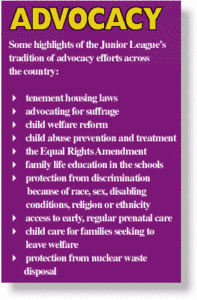 When Mary Harriman wrote the above words in the early 1900s she was calling people to action, which is a key component in advocacy. Webster’s defines advocating as pleading another’s cause or a person who speaks or writes in support of something.
When Mary Harriman wrote the above words in the early 1900s she was calling people to action, which is a key component in advocacy. Webster’s defines advocating as pleading another’s cause or a person who speaks or writes in support of something.
According to current Junior League of Miami leader Lyn Pannone, “One might define advocacy as being “political” with a small “p”. Our efforts seek to influence governmental entities as well as raise people’s awareness. Advocacy can make our shared values come alive.” She added, “As we embark upon our next 70 years, advocacy will take on even greater importance. Why? Because funds for direct service projects are becoming more scarce.”
To advocate also means to “lobby,” “to take positions,” “to improve, change or enforce public policies.” Being willing to be an advocate-to stand for what you believe -is not an idle or an isolated action. Rather, it is intimately tied to what we believe about our world.
In researching the history of advocacy in the JLM I learned about some remarkable women, true pioneers in the field.
Racial Understanding
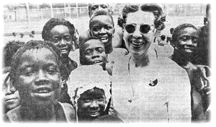 Back in 1948 Junior League Member Elizabeth Landsberg Virrick began her crusade for the rights of African Americans in her own back yard, Coconut Grove. Appalled at the poverty and living conditions, Mrs. Virrick co-founded the Coconut Grove Committee for Slum Clearance and was largely responsible for a City of Miami Ordinance passed in 1948 that required each household (residential unit) in the area to be equipped with a flush toilet and a sink, and eliminated 482 privies in the Grove.
Back in 1948 Junior League Member Elizabeth Landsberg Virrick began her crusade for the rights of African Americans in her own back yard, Coconut Grove. Appalled at the poverty and living conditions, Mrs. Virrick co-founded the Coconut Grove Committee for Slum Clearance and was largely responsible for a City of Miami Ordinance passed in 1948 that required each household (residential unit) in the area to be equipped with a flush toilet and a sink, and eliminated 482 privies in the Grove.
Mrs. Virrick also founded Coconut Grove Cares, which helps ex-offenders and disadvantaged youths. She established a day-care center, a gym and a boxing program in Coconut Grove. Mrs. Virrick continued to work for social change right up until her death in 1990 at age 93.
Hathaway Rinehart was another early crusader who “helped give birth to racial understanding.” In 1944 she fought to increase police protection for Overtown residents and worked with Father Culmer on many inner city problems,
Historian and Sustainer Arva Moore Parks McCabe explained.
“Hathaway Rinehart and Elizabeth Virrick were true pioneers. Their work on League and community activities helped steer the JLM to its current focus: Families at Risk,” Arva said.
Children’s Advocates
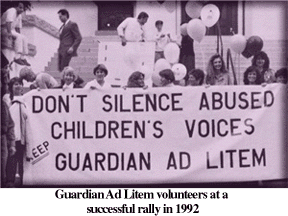 Sustainer Berta Blecke shared her League experience when she advocated on behalf of the Guardian Ad Litem Program in 1980, at which time she became involved with the State Public Affairs Committee (SPAC), an advocacy coalition formed by individual states’ Junior Leagues. Berta’s testifying as a committee chair (Children’s Issues) of SPAC before the Florida State Legislature in Tallahassee on behalf of the proposed Guardian Ad Litem Project signaled the first time that the Florida SPAC testified before the legislature. The goal was to obtain state funds for Guardian Ad Litem pilot programs in Jacksonville, Miami, Gainesville and Tampa. It is a program in which lay volunteers represent abused and neglected children caught up in the cycle of “foster care drift.” The JLM partnered with the National Council of Jewish Women on behalf of Guardian Ad Litem.
Sustainer Berta Blecke shared her League experience when she advocated on behalf of the Guardian Ad Litem Program in 1980, at which time she became involved with the State Public Affairs Committee (SPAC), an advocacy coalition formed by individual states’ Junior Leagues. Berta’s testifying as a committee chair (Children’s Issues) of SPAC before the Florida State Legislature in Tallahassee on behalf of the proposed Guardian Ad Litem Project signaled the first time that the Florida SPAC testified before the legislature. The goal was to obtain state funds for Guardian Ad Litem pilot programs in Jacksonville, Miami, Gainesville and Tampa. It is a program in which lay volunteers represent abused and neglected children caught up in the cycle of “foster care drift.” The JLM partnered with the National Council of Jewish Women on behalf of Guardian Ad Litem.
This set the stage for future advocacy efforts such as CHARLEE and INN Transition. According to Berta there is a formula when it comes to successful advocacy efforts, which includes identifying a critical need, receiving the support of community leaders (establishing a broad based community board), soliciting funds from local foundations and corporations, and ultimately implementing the project. Of course, knowing and working with legislators sympathetic to the cause is also very important, particularly when it comes to state-wide advocacy efforts. (For a closer look at the Bush family, see “Bush Legacy” article in this issue.)
She emphasized that to be a successful advocate one must have hands on experience involving the “issue” on which you are advocating. Without that expertise you would not have a complete understanding of the issue, and would therefore lack credibility. Berta continues to be active in various community projects, including the recently opened Kristi House Program for sexually abused children.
Breaking the Cycle of Violence
Sustainer Claudia Kitchens was the driving force behind the JLM signature project, INN Transition, which provides transitional housing for abused women and their children. This project officially opened its doors in 1990.
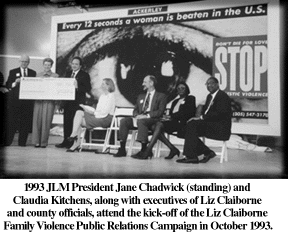 Lynn Summers, former chair of INN Transition, shared her experiences: “Advocacy is about setting the agenda and it is the one single area that can impact a wide section of the population. It is such a satisfying experience to look at the changes we have made in the community’s agenda, particularly for transitional housing for victims of domestic violence.”
Lynn Summers, former chair of INN Transition, shared her experiences: “Advocacy is about setting the agenda and it is the one single area that can impact a wide section of the population. It is such a satisfying experience to look at the changes we have made in the community’s agenda, particularly for transitional housing for victims of domestic violence.”
Claudia explained, “Advocacy involves multiple levels to change policy and public perception in solving problems.” Claudia served as chair of SPAC in 1990. She feels advocacy efforts have grown dramatically in the last 15 years in Junior Leagues across the country. She credits JLM’s experience with local advocacy efforts beginning in the 1970s with historic preservation and environmentalism.
“SPAC provided women with the necessary skills so they could go back to their respective Junior Leagues and make their members comfortable with the concept of advocacy as a part of community projects.
“We learned that because of our projects we were the experts. Political leaders began to see us as leaders who came prepared and understood the issues,” she added. Claudia shared one of the most powerful statements she heard in the late 1980s in Washington, D.C. at an Association of Junior League International-sponsored National Public Affairs Conference. The speaker, Senator Patrick Moynihan, “…. If there is an issue pending that deals with oil or transportation, the Halls of Congress would be filled with lobbyists in Gucci loafers. However, if the issue happens to be poor children or those without supporters, we can always count on the Junior League to be there.”
ENVIRONMENTAL AWARENESS
RECLAIMING THE RIVER & OTHER ACTS OF ENVIRONMENTAL KINDNESS
By Susan Revello
The active members of the Junior League of Miami in 1970 learned some valuable lessons about their perceived role in the Miami community and they turned the tide quite literally, with the Miami River Restoration Project.
Sustainer Janice Pryor, who then chaired the Community Arts Committee said, “We initiated the concept of cleaning up the Miami River and when we presented it to various community and civic leaders their attitude toward us was very cavalier. . . they thought of it as a pipe dream.”
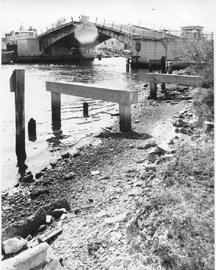 This however, just increased the League’s determination to make this project a reality. That summer they went beyond “rolling up their sleeves” –they literally surveyed the river in two-woman teams, climbing embankments and working around the debris, as well as some street people who frequented the area.
This however, just increased the League’s determination to make this project a reality. That summer they went beyond “rolling up their sleeves” –they literally surveyed the river in two-woman teams, climbing embankments and working around the debris, as well as some street people who frequented the area.
Once they had assembled the research which consisted of information on property owners, zoning requirements, conditions of the river, ordinances governing the river and if applicable, present use and condition of bulkheading, they had the foundation for the project. Two League members actually attended a course in pollution control at Miami Dade Junior College, South Campus.
Thus, before environmentalism was a widely embraced “cause” the JLM vigorously pursued efforts to reclaim the Miami River from the jaws of its polluters. They finally got the public’s attention through the efforts of newly elected Secretary of State Richard Stone, who attended a League meeting in November 1970. In a letter to Janice Pryor dated Jan. 14, 1971, The Honorable Richard Stone wrote, “Our mutual purpose is to concentrate and coordinate all of our efforts so that we can evolve responsible joint plans with mutually agreed upon deadlines for accomplishments to the end that within a measurable span of time the Miami River will become useable, beautiful and a credit to the people of Florida and our country.”
Of course, it had not always been like that. For centuries the Miami River, although only a little more than four miles long, had been an important waterway between the bay and the interior. The River called Mayaimi, meaning “Sweetwater” to the Indians, once ran crystal clear and Indians in dugouts watched “sea cows” frolic on the bottom, not to mention schools of mangrove snappers. The problems began soon after Miami became a city in 1896. The fast-growing community dumped its sewage into the river, creating a sewer out of what had once been a clear stream teeming with fish.
With the boom of the 1920s and then the work of the Army Corps of Engineers dredging the Everlades via the river as part of their combination navigation and flood control project, conditions on the river had worsened to a deplorable state by 1970.
The Idea Catches On
Senator Stone’s involvement resulted in a great deal of publicity about the river clean-up. The goal of the League to alert, educate and encourage the community to achieve desired ecological goals was well underway. Several members appeared on local television stations discussing the project. The second phase of the project was to ensure that now that the ball was rolling, no governmental agencies dropped it.
The headline in an article inThe Miami Herald in March 1971 said, “Women Plan to Be Meanies Until Miami River Is Cleaned Up.” The article talked about the lack of successful clean-up efforts during the previous 10 years. It went on to state that “Beginning next week, a handful of women from the Junior League of Miami will begin watching the progress of the current clean-up campaign and start dogging public agencies to see that promises of improvement are fulfilled.”
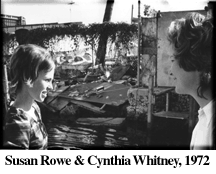 “If we pester enough — say, every week or 10 days making a call to the same person to ask them what’s been happening — they’ll realize the community is interested,” explained Mrs. Cynthia Whitney, chair of the River Restoration Committee.
“If we pester enough — say, every week or 10 days making a call to the same person to ask them what’s been happening — they’ll realize the community is interested,” explained Mrs. Cynthia Whitney, chair of the River Restoration Committee.
She went on to add, “They won’t be able to give us excuses; we will be able to call their bluff. And the Coast Guard has been very cooperative, but sometimes they need prodding too.” Mary Harriman, founder of the Junior League in 1901, would have been very proud.
In fact, the JLM received an award from Florida East Coast Properties, Inc. for “its initiative and perseverance in spearheading the revitalization of the Downtown Waterfront” in November 1972.
The Miami River project turned out to be the first of many environmental projects supported by the JLM over the years.
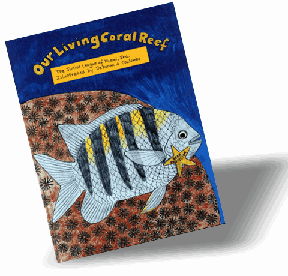 Protecting Biscayne Bay and Its Treasures
Protecting Biscayne Bay and Its Treasures
In Spring 1991 “Living With Nature” was implemented in cooperation with the Biscayne Nature Center. Almost a decade earlier, environmentalist Marjory Stoneman Douglas requested that a task force be formed to study the possibility of placing a nature center at the site on the north end of Key Biscayne, one of the last remaining coastal hammock environments in Dade County. In 1985 the Marjory Stoneman Douglas Biscayne Nature Center was official.
Junior League “Living With Nature” Committee Members under the chairmanship of Jayne Harris Abess served as guides at the Biscayne Nature Center where they educated people about our fragile eco-systems.
As a result of her placement, committee member and subsequent Chair Theodora Long permanently joined the Biscayne Nature Center as executive director, where she continues to work today.
In addition to guiding the educational excursions, the JLM created a children’s coloring book about the living coral reef, which was translated into Spanish and Creole. The League also produced T-Shirts and a volunteer training manual. This project went on to win “The Take Pride in Florida” Award from the Department of Natural Resources.
Water Conservation
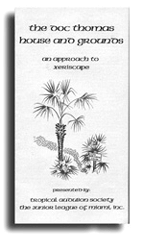 In response to water shortages in South Florida, the JLM teamed up with the Tropical Audubon Society during the 1991 -92 League year, to promote the concept of xeriscaping. Xeriscaping balances beautiful landscaping with water preservation. Up to 50 percent of water consumption is attributable to landscaping. Xeriscaping would conserve 80 percent of that amount.
In response to water shortages in South Florida, the JLM teamed up with the Tropical Audubon Society during the 1991 -92 League year, to promote the concept of xeriscaping. Xeriscaping balances beautiful landscaping with water preservation. Up to 50 percent of water consumption is attributable to landscaping. Xeriscaping would conserve 80 percent of that amount.
Under the chairmanship of Cecilia Jude Prahl, the Xeriscape Committee teamed up with the Tropical Audubon Society after they received a grant from Southern Bell for the xeriscape site. The site is located in the garden area east of the historic Doc Thomas House in South Miami, home of the Tropical Audubon Society. Volunteers from the JLM conducted free tours of the site and produced a self-guided tour brochure.
Cecila Prahl described the work of her committee:
“We would begin our tours with a visit to the Doc Thomas house, followed by a brief video about the seven principles of xeriscaping. Then we’d give visitors a plant-by-plant tour of the site, which contained 61 different varieties. We explained how tall the plants would grow, light requirements, etc., and then we would answer specific questions.”
HISTORICAL APPRECIATION OF MIAMI’S GLORIOUS PAST
By Laurie Schobelock
To many, Miami is just a “babe in arms,” but 100 years as a full fledged, fast growing city can produce a lot of fascinating history. In addition, this area was inhabited by Native Americans for thousands of years before the founders of Miami made their way to the glistening waters of Biscayne Bay. Members of the Junior League of Miami recognized the richness of Dade County’s history and made efforts to preserve some of the available artifacts and to ensure that the facts were recorded for posterity.
One of the first endeavors was a program brought to the League in 1969 called Pioneer Voices. Miami was in the unique position of having many of its earliest pioneers still living, so the League was asked to organize a program to record their memories. This effort not only produced oral histories, but a collection of photographs and historical documents. During the 1971 – 72 League year, Cuban Oral History was added to the Pioneer Voices collection. Here’s John Pickett Miles remembering the 1926 hurricane:
“Clyde Court Apartments was a reinforced concrete building and was supposed to be just about indestructible. Well, that hurricane took the back, the south wall off Clyde Court, just like you’d take a knife and cut into a pasteboard box. My mother was sitting up in bed with the Bible in one hand and an umbrella in the other, and looking out over the south side of Miami just as if there was no wall there, because actually, there wasn’t.”
Nancy Clemens of the JLM interviewed Mr. Miles in 1970 as part of the Pioneer Voices project. All the audio tapes and transcriptions from this project were donated to the collection of the Historical Museum of Southern Florida so that they are available to researchers and the general public.
During that same time period, Leaguer Sheldon Morehead heard of the Florida Eastcoast Railway’s plans to dispose of The Princeton Florida Railway Station in South Dade. She started a successful one-woman campaign to save it. After receiving tentative permission to purchase the building if a use could be found for it, she contacted A.D. Barnes, director of the Dade County Parks and Recreation Department, and many meetings later, made arrangements for the station to be moved to the miniature train concession at Crandon Park on Key Biscayne. The concessionaires, park supervisors, carpenters and many others agreed to pay the $5,000 cost to relocate the station if it was purchased and donated to the County. When these preservation plans were presented to the League, the membership voted unanimously to purchase the station and donate it. On October 22, 1968, the Board of County Commissioners accepted the gift of the League and passed a resolution of gratitude. On five dark nights in November the drab, weather-beaten little station made the 31-mile journey from Princeton to Crandon Park. The building was completely restored with the exception of huge cobwebs which were left on the baggage room rafters as a symbol of age. The official dedication took place on March 29, 1969, amid much fanfare.
In August 1992, Hurricane Andrew, destroyed the Princeton station.
In 1972, efforts to record our history began with the first of our historical films, Ours is a Tropic Land. (This award-winning film and those that followed are discussed in Caught on Camera, early in this issue.)
In addition to the film, the League granted $20,000 to the Historical Association of Southern Florida to furnish and equip a research library in their new museum and to help establish a volunteer training program.
Nestled just off busy Coral Way is one of Coral Gables’ most important historic sites. “Coral Gables House” was the family home of Coral Gables’ founder, George Merrick. In May of 1976 the City acquired this historic landmark. Several organizations, including the League, were instrumental in returning Merrick Manor to its original gracious state.
On the heels of the premiere of Miami, The Magic City, the second of the League’s three historical documentaries, came the publication of five self-guided historical tour books. The series started in 1984 with Historic Downtown Miami, produced with League womanpower and financing, as well as a $5,000 grant from the Bureau of Historic Preservation, State of Florida Department of State. The sign of a job well done is often receiving another job, which is exactly what happened. In 1985, when the Historic Downtown Miami book was published, the League received another $5,000 from the Bureau of Historic Preservation to start another book. Research began immediately on a self-guided tour of Coral Gables.
Following the Coral Gables booklet came Coconut Grove in 1987, South Dade in 1988 and Northeast Dade in 1990. These handsome booklets received recognition from the Florida Trust for Historic Preservation in 1990 – 1991 and are still popular today. The two most popular, Coral Gables and Coconut Grove, have been out of print for two years. The Junior League of Miami, perhaps with support from a community partner, may reprint the booklets someday.
The dust had not settled from the last self-guided tour when the League started production on the third version of our historic film, Our Miami: The Magic City. In addition we served as “step-aboard” tour guides for attendees at the annual meeting of the National Trust for Historic Preservation scheduled to be held in Miami in the fall of 1992. Along came Hurricane Andrew, but with the spirit of our brave pioneers, the conference went on and was a big success.
What about the present Junior League involvement with historic preservation? On December 28, 1995, we closed on the purchase of the historic Venetian-style building located at 713 Biltmore Way. This landmark is our new headquarters and will be renovated during the next few years. Thus, the League continues its appreciation and commitment to the preservation of Miami’s glorious past.
